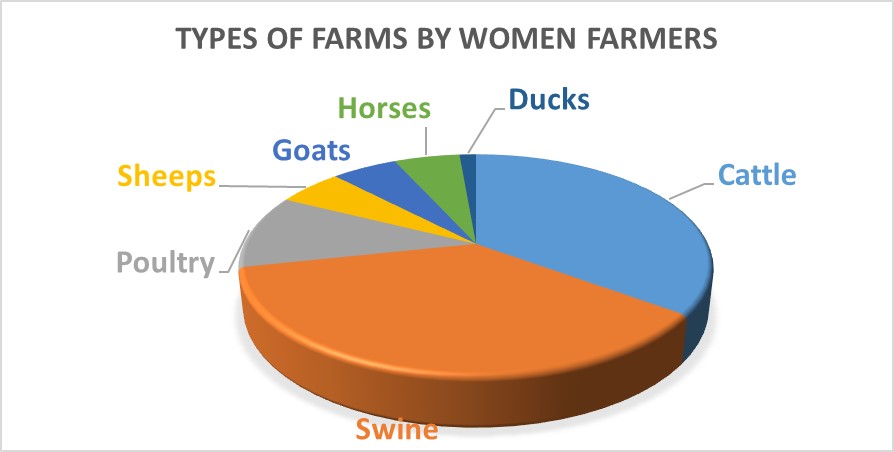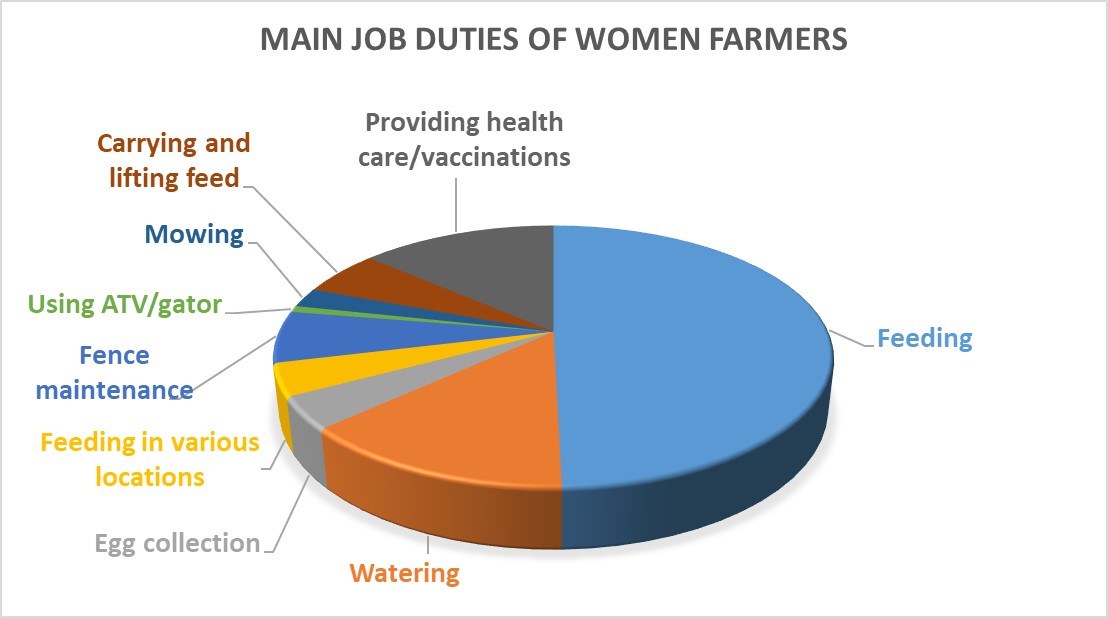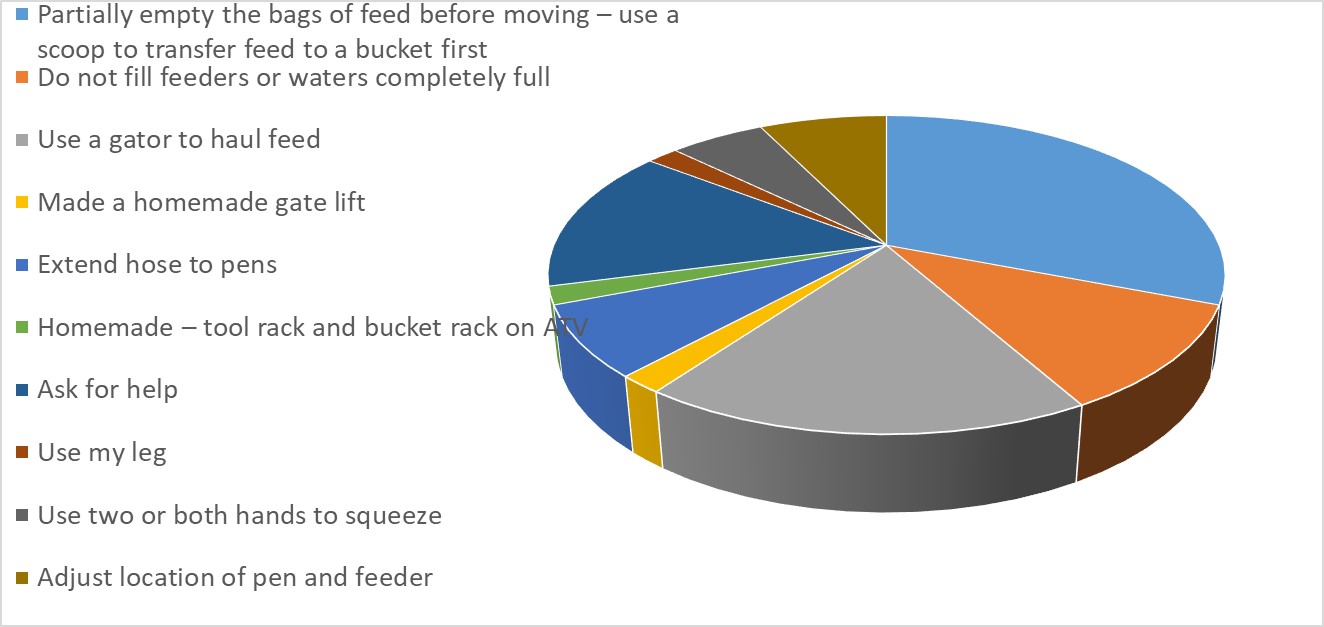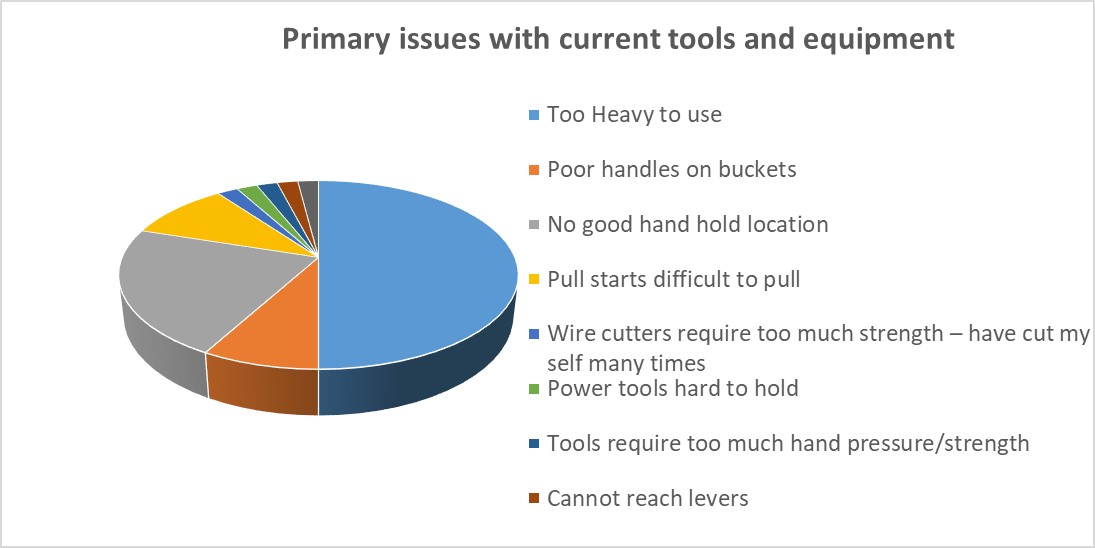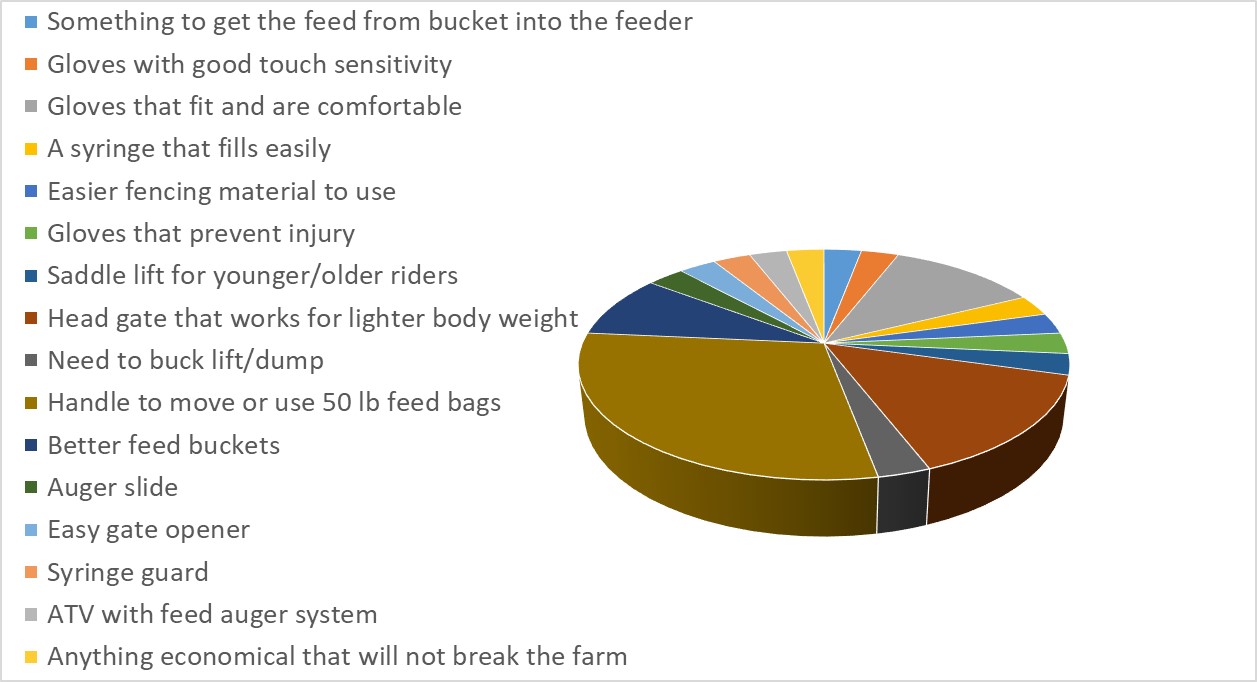Progress report for LNC21-458
Project Information
Women make up a growing share of principal farm operators, especially on farms engaged in sustainable agriculture. The 2017 census showed that nearly 30% of farms in the US are farmed by women as principal farm operators. In Missouri, there are 59,000 women being part of a farm. However, almost all farm tools and equipment are designed based on the average size of men farmers. There are no on-going research efforts investigating the safety and health risks due to a mismatch between the physical capacity of women farmers and the physical demands of their jobs with regard to farm tools and equipment. Meanwhile, current safety education for the agricultural population is often aimed at men, but women may be less prepared to prevent injuries, illness, and chronic conditions related to agriculture work. The goal of this project aims to improve the safety and health for women farmers by identifying essential issues of farm tools and equipment used by women farmers, and providing solutions through presenting education programs, providing simple solutions, and developing next-generation tools using ergonomic, engineering, automation and smart technology standards. Surveys and field evaluation will be conducted on selected tools and equipment using by women farmers on animal and crop production to identify the essential issues (injury, illness, chronic conditions, disability or death), which will be analyzed and classified into different categories (e.g., design flaw, inappropriate design and operation, outdated products). Education programs will be presented to increase the awareness of the potential hazards and knowledge of properly selecting and using tools. We will develop simple ergonomic solutions to improve the safety and health for women farmers, and also develop next-generation tools and equipment as potential long-term solutions. We will work closely with women farmers, who will serve as cooperators, advisory team members and collaborators, to collect first-hand information, and guide the implementation of the proposed research. Project outcomes and findings will be shared with women farmers in the NCR and US to improve their safety, health and efficiency in use of farm tools and equipment. The long-term impact of the project will reduce farm injuries, improve women farmers health and safety, and improve the overall sustainability of agriculture in the NCR. This project will contribute to the NCR-SARE broad-based outcomes: improved farm equipment will increase the profitability and associated agricultural businesses, enhance the life quality of farmers and environment in the long run.
The project aims to address the safety and health issues of farm tools and equipment for women farmers, including three supportive objectives: (1) Understand essential issues of the farm tools, worksites and equipment for women farmers through survey and technical evaluations; (2) Generate awareness, knowledge and resources for women farmers to use farm tools and equipment properly though education programs; and (3) Provide simple solutions and develop next-generation tools for women farmers using ergonomic, engineering, automation and smart technology standards. The project outcome will improve the sustainability of agriculture with improved efficiency, effectiveness, and sustainable farming practices.
There are few studies in the US having been conducted to investigate the critical issues of farm tools and equipment related to the safety and health of women farmers, nor efforts from the public and private sectors to provide solutions to address these issues. There is a pressing need to investigate these issues and provide necessary knowledge and solutions to improve the safety and health for women farmers, who are the key contributors to sustainable agriculture. A research team from the University of Missouri and collaborative institutions with multiple disciplinary backgrounds, including engineers, health and safety specialists and extension and education specialists will collaboratively work together to address such issues. We believe our team have the exceptional abilities, experiences and appropriate connections to women farmers and the NCR networks, as well as a solid foundation to accomplish proposed activities.
We believe that the issues of equipment and tools for women farmers can be addressed by increasing their awareness and knowledge to properly operate farm tools and equipment, and by accessing right tools and equipment that fit to their body conditions. Through this project, we expect to collect sufficient information on the essential issues regarding farm tools and equipment used in different types of agriculture production (e.g., cattle beef, dairy, swine, goat, and crops). We will conduct ergonomic assessments to evaluate the safety and efficiency of tools and equipment, which will provide baseline information for developing education programs and next-generation tools using the latest technology standards. We hope to develop education programs, provide sufficient resources for women farmers to access alternative and next-generation farm tools and equipment by collaboratively working with farmers, engineers, occupational and physical therapists and university extension specialists.
Cooperators
Research
Women farmer's safety and health could be improved through optimizing their farming tools and equipment.
The project will be conducted using an interdisciplinary method with close collaboration of Researchers, Cooperators, Advisory Committee farmers, Extension specialists and their networks. The project will be conducted with the following four tasks to meet the project goal and objectives.
Task 1. Conduct surveys to identify essential issues of farm tools and equipment used by women farmers
We will collect demographic information of farmers, their farms, major tools and equipment used, essential safety and health issues (injury, illness, chronic conditions, disability or death), their dream tools and other related questions. Survey questions will be carefully designed for different groups based on their interests and extent of participation. Surveys will be updated based on needs and experience learnt as the project going. Different survey methods will be used to maximize the participants of women farmers, including in-person or video interview, online survey (social media), focus group discussion, direct mail survey and conference survey. Using survey methodology of both written and oral questionnaires will enable us to ask different types of question, collect precise answers with higher rates of responses. In addition, focus groups will be used to synergize and get clarity on the everyday real-world issues with farm tools and equipment that need to be adapted from the survey results.
The methods of online survey and direct mail will be the primary and the most promising method to reach a large number of women farmers in all NCR states. We will use commercial online survey tools (e.g., Qualtrics, Survey Monkey), social media (e.g., Facebook or Tweeter) and project website to interact with women farmers. Survey emails, notifications or mails will be directly delivered to target women farmers. We will select target audiences from our identified in-network women farmers and then extend to a large population in all NCR states. We will utilize the strong extension networks of the University of Missouri, including different programs working with local and regional women farmers to connect target audiences for this project. In addition, extension field specialists will also help this project to get connected with women farmers. We will attend regional or national grower meetings, such as Great Plains Growers Conference, Western Farm Show to reach a wide range of audiences.
In-person interviews and focus group meetings are the more reliable methods to collect information and directly interact with women farmers. We have identified a strong network for conducting surveys, including project Cooperators, Advisory Committee and collaborators who are women farmers or regional field specialists. The collaborators will provide leadership in organizing focus group meetings or field demonstrations to provide opportunities for in-person interactions with farmers at local or regional areas. The identified collaborators cover different productions , such as (1) beef production (Carey Portell, Brenda Schreck/Susan Jaster), (2) dairy production (Kendra Graham, Reagan Bluel) and (3) small animal production (Corinne Bromfield, Susan Butterfield). Although we will focus on animal and dairy production, we will also include a small portion of vegetable production (Liz Graznak, Christy Green). We will closely work with extension specialists and other organizations (see Support Letters) who will remotely participate in discussions. In addition, Co-PDs Funkenbusch and Shannon have long-term collaborations with many extension specialists and farmers in NCR through other projects, such as Pearls of Production, Women in Dairy, Annie’s Project, USDA Beginning Farmers and Ranchers Development Program, USDA State-level AgrAbility program and USDA 2501 Program.
The surveys will be primarily conducted in year 1 and continue in year 2 and year 3. Revisits will be planned in the third year of this project to collect their feedbacks. Our goal is to reach an average of approximate 1,000 women farmers each year in the 12 NCR states. We expected to receive responses from around 400 women farmers each year. All survey results will be collected in a timely manner (< 6 months), and analyzed using methods of the University of Missouri Extension evaluation procedures. Statistical results will be weighted based sample size with margin of error (95% confidence interval) and sampling response rate (>30%). A complete report will be generated to provide details on the issues of safety and health for women farmers due to farm tools and equipment. The survey results will provide baseline information for taking corresponding actions to improve the safety and health of women farmers in using farm tools and equipment.
Task 2. Evaluate the efficiency, safety and health features of farm tools and equipment widely used by women farmers. (Led by Zhou, Funkenbusch, Shannon)
Based on preliminary survey, the responses of different famers to the issues of tools and equipment were not consistent. Therefore, it is needed to understand the reasons of the safety and health hazards caused by farm tools and equipment. We will conduct ergonomic assessments on selected farm tools and equipment using the popular ergonomic assessment methods, such as Rapid Entire Body Assessment (REBA), Rapid Upper Limb Assessment (RULA), Posture, Activity, Tools, and Handling (PATH) and Ovako Working-posture Analysis System (OWAS). We will work with collaborative farmers and cooperators to conduct the field evaluation.
Women farmers or volunteers will be recruited to conduct the assessment of the selected tools and equipment. Instrument will be used monitor their heart rate, blook oxygen level, stress level and other needed body indicators. Video cameras will be used to record their activities and methods to use the tools and equipment. Data will be analyzed to evaluate the safety and health features of the tested tools and equipment. Recommendations on how to use them properly and improve the efficiency and safety will be documented and published. In addition, the assessment results will also provide baseline information on how to adapt and develop next-generation tools and equipment, and provide recommendations for the industry standard communities and associated industries for referencing.
The ergonomic assessment will also be conducted for some new tools to identify a list of alternative tools that are suitable for women farmers. We will work with tool manufacturers, experienced farmers and field specialists to develop guidance for the identified tools and equipment. Based on assessment results and survey, a collective set of farm tools and equipment will be labeled into different categories for different farm activities according to their features. Such information will be included in an online information center (database) to be developed as part of our project website and will be available to public. The online information center will provide a convenient space for women farmers and related stakeholders to select right tools and equipment for their farm operations. We expect the online information database will include sufficient and latest resources about the farm tools and equipment for different agricultural productions. The website will keep updating with the project moving forward and afterward. To generate broader impacts, we will also publish our research findings in professional websites, including National Agricultural Safety and Health eXtension Community of Practice (see Support Letter), NIOSH and Occupational Health and Safety Administration (OHSA).
Task 3. Develop education programs and conduct extension activates for women farmers to select and use tools and equipment properly. (Led by Funkenbusch)
We will develop education programs and conduct extension activities to deliver knowledge to women farmers through workshops, webinars, on-farm demonstrations, publications (paper and videos), targeted social media outlets, and online tutorials.
A series of workshops will be conducted in Missouri and other NCR states through collaborators and extension network to provide women farmers trainings on how to use tools and operate equipment safely. We will also provide scholarships to cover the expenses for some participants to attract more women farmers to participate in our hands-on, face-to-face women-led workshops. Pearls of Production and the Women in Dairy programs will be key efforts when establishing educational workshops (see Budget Justification). We will work with Cooperative women farmers and farmers from an Advisory committee to organize on-farm demonstrations. All aspects of farming will be utilized such as beef cattle handling, animal movement, feeding of animals, and small equipment operations. These farming tasks will vary depending on the season of the year or stage of animal production.
This project is endorsed by experts from multiple institutions in NCR states (see Support Letters), including the Upper Midwest Agricultural Safety and Health Center at University of Minnesota, Great Plains Center for Agricultural Health at Iowa State University, Central States Center for Agricultural Safety and Health at the University of Nebraska Medical Center, regional and state AgrAbility programs. We will closely work with the collaborative experts and institutions to organize workshops, develop curricula for education programs and distribute our research results to a wide range of women farmers in NCR.
A project website will be developed as a platform for interaction with women farmers, industries and related stakeholders. It will be used to announce events, access training materials and demonstration videos on operation of tools and equipment. We will also setup a YouTube channel and add our work to the eXtension, U.S. Agricultural Safety and Health Centers, and NASD: National Ag Safety Database.
Task 4: Develop next-generation tools and equipment for women farmers using ergonomic, engineering, automation and smart technologies. (Led by Zhou)
This project will develop two layers of solutions, i.e., “simple solutions” and “comprehensive solutions”, to make daily used tools and equipment safer and more efficient using ergonomic and engineering technologies. We will follow the concept developed in one of the most successful and influential publications titled Simple Solutions: Ergonomics for Farm Workers, published by NIOSH in 2001. The booklet provides some “simple ergonomic solutions” that farms have tried out and are potentially to be adapted in other farm operations to make work safer or easier. It also includes some tools invented by UC Agricultural Ergonomics Research Center and other institutions. Since the procedures and solutions developed in this booklet were widely accepted by farmers and educator, this model will help the success of this project.
We will develop “simple solutions” for women farmers using the updated technologies in ergonomics, engineering, automation and digital technologies following two basic rules: (a) cost-effective and result in quick savings, and (b) should improve safety and health for women farmers. We will also develop “tip sheets” with illustrations on how to operate the tools and equipment properly, and how to modify existing ones to reduce the risks. Some examples include adaption and adjustment of off-the-shelf devices. Some potential yet simple solutions that farmers and industries can do themselves will be developed based on the results from Task 1 and Task 2. The developed simple solutions are expected to be easily used by women farmers and provide “immediate” impact on improving the safety and health for women farmers. The validated solutions will be introduced to women farmers through focus group meetings, workshops, YouTube videos and extension and journal publications to generate more impact.
In addition, we will explore comprehensive solutions that will address more than one issues and add additional safety and health features through developing next-generation farm tools and equipment using ergonomic, engineering, automation and smart technologies. We will collaborate with engineers and local machine shops to develop prototypes. We will carefully document all creative work during the design and ideas exploration. Invention disclosures and patents will be filed through the University of Missouri to seek the potential of commercialization. The research results will be used to apply additional grant support, such USDA Small Business Innovation Research Program (SBIR) and other related funding opportunities, so that the project can be after the completion of this funding cycle.
In addition, we will actively involve in the professional and standard communities in agriculture sector to revise or develop industrial standards that include sufficient information regarding safety and health for women farmers. PD Zhou, Co-PDs Shannon and Funkenbusch are already members of some communities, such as NCERA 197: Agricultural Safety and Health Research and Extension, International Society for Agricultural Safety & Health (ISASH), and Agricultural Safety and Health Council of America (ASHCA). We will continuously create more impacts through close collaborations with the professional communities.
The response to our survey questions:
- Information about your farm, such as type of production (e.g., cattle, dairy, swine, vegetables …) and number of animals/acres.
- What are your main job duties on the farm (feeding, hauling, carrying, lifting, …).
- What everyday tools and equipment are used on your farm(s)?
- When using a tool or equipment, what adjustments do you need to make to prevent injury or make the tool/equipment easier to use?
- What are the 5- 10 issues or complaints of the current tools or equipment that you use.
- Have you or others on your farm been injured due to poorly designed tools and equipment? If yes, please provide some details about how injury happened and how we can improve tools.
- List 2-3 dream tools/equipment that you would love to have to help you.
Education
The general approaches include:
- Field or on-site demonstration of tools and equipment: Women farmers can see and touch them to have a better understanding;
- Hands out or brochures: provide take-home materials they can learn more later
- Farmers teach farmers: Invite experienced women farmers to give talks and demonstrations
Project Activities
Educational & Outreach Activities
- Missouri state Fair;
- AgConnect
- Western Farm Show
- Livestock Symposium – December 4th, 2021 (50 women)
- Women in Ag Raising Pork – June 25th, 2022 (20 women)
- Springfield Ag Meeting – September 9, 2022 (25 women)
- Swine Educators Conference – October 25-27th, 2022 (65 women)
- Pearls of Production – November 4-5th, 2022 (40 women)
- North Central Regional Producers – November 14-15th, 2022 (~90 women)
- Higginsville Producers Night – January 28, 2023 (20 women)
- Shelby County Ag Night – February 9, 2023 (20 women)
Participation Summary:
Learning Outcomes
- General knowledge about Agriculture ergonomic tools and equipment
- Available ergonomic hand tools, long handled tools, livestock tools and other tools of interest to women producers
- How women farmers can use tools differently to improve their health and safety
Project Outcomes
Information Products
- Safety and health of women farmers using farm tools – a survey (Conference/Presentation Material)
